The best small company cars for tiny BIK rates
Sometimes the best things really do come in small packages, as these compact company cars prove

News
by Jack Warrick
7 mins read
18 July 2025
Share
When it comes to choosing a company car, smaller often means smarter.
These agile and economical models deliver significant benefits, from reduced running costs and easier urban navigation to lower benefit-in-kind (BIK) tax implications.
In today’s market, smaller no longer means compromising. The best small company cars offer surprising spaciousness, premium features and impressive performance.
But which small company cars should you actually consider? Our comprehensive guide reveals the top compact vehicles that combine efficiency, practicality and driving enjoyment, but also low BIK rates to save you some cash.
We’ve considered all types of electrified models here, so whether you’re after a fuel-efficient hybrid, a zero-emission electric car or a versatile hatchback or crossover, our hand-picked selection covers all bases.
Our top choice for the best small company car available today is the Volkswagen Golf eHybrid, with its huge all-electric range, low 5% BIK banding and all-round drivability. Read on to see which other models join it in our top 10…
1. Volkswagen Golf eHybrid
9
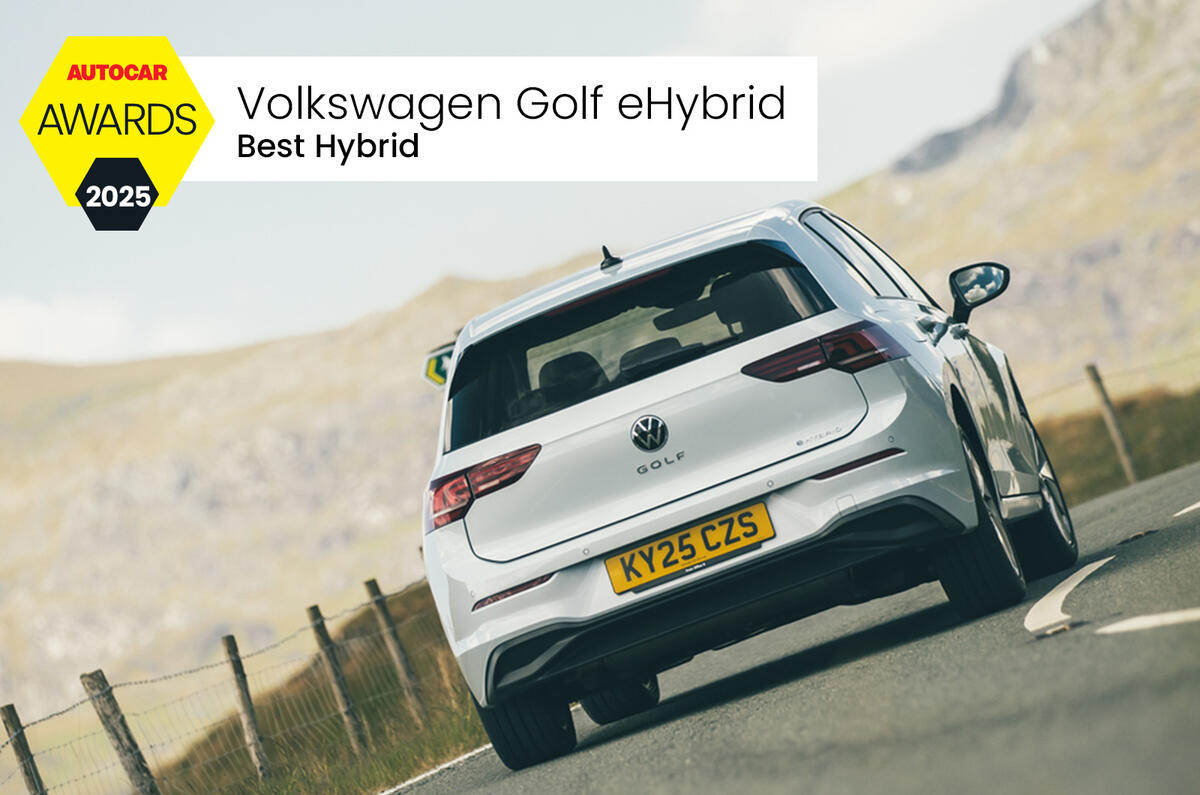
- Design10
- Interior8
- Performance8
- Ride & Handling9
- Costs10
Pros
Smooth, efficient and well-integrated hybrid powertrain
Decent fun to drive and comfortable as well
Claimed EV range is class-leading
Cons
Recent facelift is a little fussy
Interior and boot trail the biggest for space
Won’t wow in the company car park
Best for: All-around ability
Few compact cars offer such a compelling blend of talents as the Volkswagen Golf, and it’s the best small company car available in the UK today.
In electric-only running, the 3.4mpkWh average in mixed-road testing is in itself competitive with full EVs of a similar size. If you’re economy-minded, you’ll readily get 4.0mpkWh from the battery – even on a motorway.
The German machine’s blend of understated style, upmarket feel and decent practicality makes it the perfect choice for drivers needing to mix a busy working week with a full-on family life.
There are standard petrol and diesel versions, plus a mild hybrid, but the plug-in hybrid is best for business users. It uses a 201bhp petrol-electric drivetrain that delivers punchy performance, but the headline here is its huge 25.7kWh battery and the electric-only range that brings.
With a claimed 88 miles, the Golf hatch has one of the longest EV ranges on the market today. It also slots the car nicely into a 5% benefit-in-kind rating.
Read our Volkswagen Golf eHybrid review
Save money on a new Volkswagen Golf with What Car?
Finance this car with Drivenfi
Latest Reviews

Porsche 911 GT3

BMW iX
9

Used Suzuki Jimny 2018-2020 review
7
Used Suzuki Jimny 2018-2020 review

Skoda Enyaq vRS
7

Audi RS3
8
Read our review
Car review

Volkswagen Golf
Facelifted Golf gains much-needed interior upgrades and new base four-cylinder engine. Is it better than ever?
Back to top
2. Audi A3
8

- Design8
- Interior8
- Performance8
- Ride & Handling8
- Costs9
Pros
Still cuts quite a dash
Interior feels a cut above in terms of quality
Poised and capable
Cons
There’s not much in the way of driver connection
The plug-in hybrid is still a little way off
Sport suspension a bit too harsh
Best for: A premium feel
It’s perhaps unkind to call the Audi A3 Sportback a VW Golf in a posh suit, but in many respects that’s exactly what it is.
However it’s propelled, and largely irrespective of its specification, the A3 remains one of the biggest-feeling small cars around.
Underpinned by the same MQB platform and using largely the same range of engines, the Audi offers similar levels of space, poise and performance, but wraps it up in a more stylish package that benefits from the greater kudos that comes with the four-ringed badge on its front grille.
Like the Golf, the A3 has been treated to a mid-life refresh that extends to sharper exterior design and an even more upmarket interior. As before, there’s also the option of a saloon version for those wanting that traditional company car vibe.
The best engine for company car drivers is the same plug-in hybrid powertrain used in the Volkswagen Golf eHybrid. You’ll get 201bhp and a 0-62mph time of 7.4sec but, most importantly, that 88-mile EV-only range, which results in a 5% BIK banding.
Read our Audi A3 review
Save money on a new Audi A3 with What Car?
Finance this car with Drivenfi
3. Mini Cooper SE
8
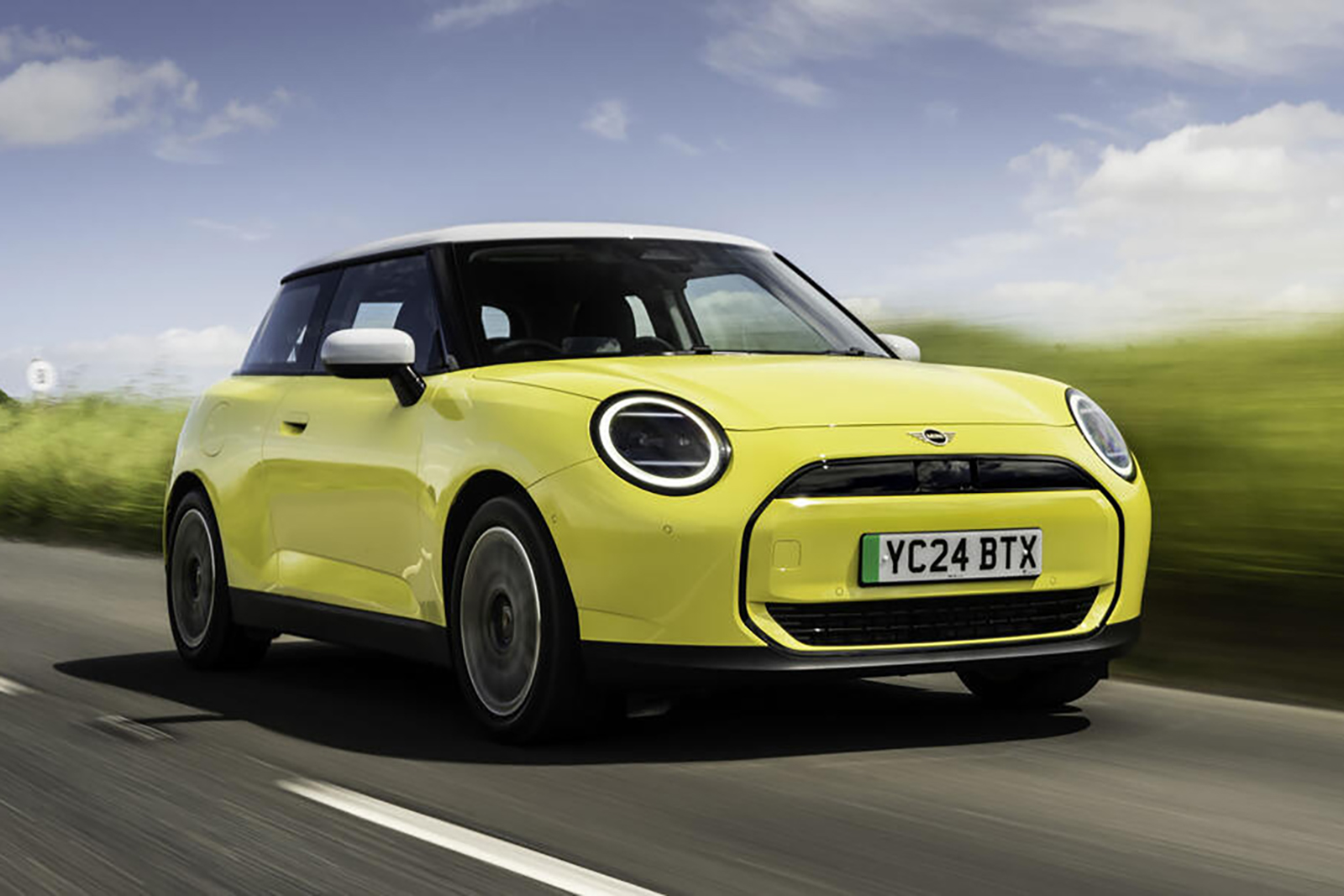
- Design10
- Interior8
- Performance9
- Ride & Handling8
- Costs8
Pros
Decent electric range
Enough old-school Mini character to keep things interesting
Classy cabin and decent infotainment
Cons
It’s really too big to be called a Mini
Some low-speed ride hyperactivity
Big-battery model feels heavy
Best for: Engagement
The original electric Mini Cooper was big on fun yet small on range, but for this all-new model, the British brand has injected a little extra stamina.
This second-generation electric Mini is certainly a more grown-up electric car than the original.
In fact, on the flagship Cooper SE (there’s also a cheaper and less rangy Cooper E), battery capacity has been increased from the old car’s 28.9kWh to a far more handy 49.2kWh. That means a useful claimed range of 224 miles, not far off twice the distance of its predecessor.
However, this boost in battery capacity has also come with an overall increase in size, to the point that it’s a bit of a stretch to call the car a Mini. Still, it’s the most roomy three-door the firm has ever made, while the interior features enhanced premium appeal and some glitzy-looking tech.
Crucially, the Mini retains enough of its trademark agility and back-road boisterousness – not to mention occasionally hyperactive ride – to keep things interesting, with fast steering, strong grip and a low-roll stance.
And when you’ve had your fun on the way home from work, you can relax in the knowledge that you’re paying a piffling 3% BIK bill
Read our Mini Cooper SE review
Save money on a new Mini Cooper with What Car?
Finance this car with Drivenfi
Back to top
4. MG 4
8
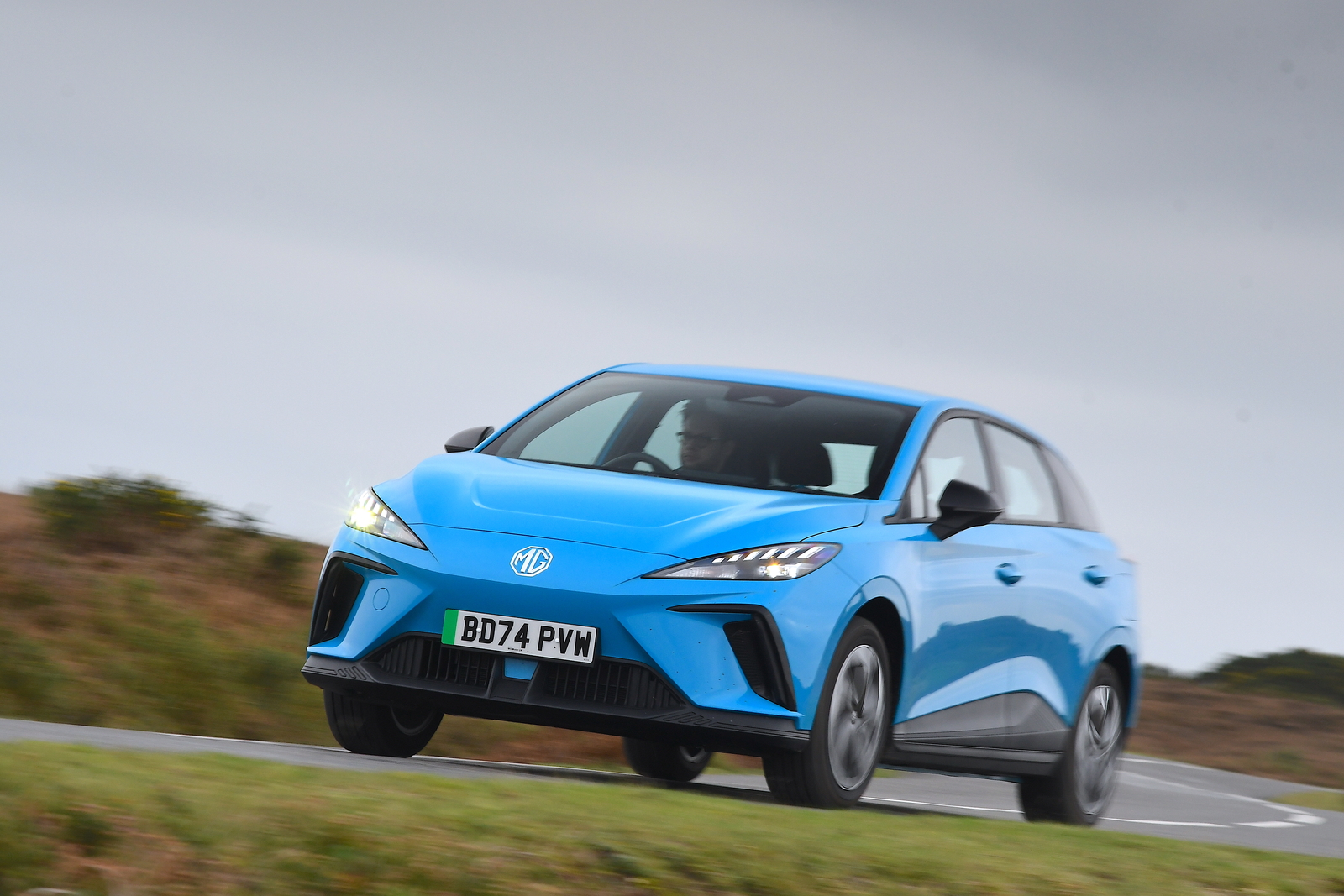
- Design8
- Interior7
- Performance8
- Ride & Handling8
- Costs8
Pros
A lot of car for the cash
More engaging to drive than you’d think
Decent dose of practicality
Cons
Interior finish still not up to mainstream standards
One or two ergonomic niggles
Driver assistance features need refining
Best for: Practicality
The MG 4 is a great choice for those seeking an affordable electric company car.
It is up there with the Cupra Born for chassis sophistication, in the right specification delivering both a comfortable ride and an enjoyable rear-drive balance.
Like other models in the MG range, the chunky hatchback comfortably undercuts the competition on price and does so with some head-turning style and a premium-feeling interior ambience.
It’s also good to drive, with biddable handling and a decent turn of speed, even in entry-level 158bhp guise. Apart from a relatively firm low-speed gait, the MG 4 rides bumps with an easygoing demeanour.
There’s a range of battery options, with everything from 51kWh to 77kWh. However, it’s the 64kWh version in the SE Long Range that delivers the best blend of distance (281 miles) and price (a whisker under £30,000).
With a 3% BIK rating, it’ll cost lower-rate earners a maximum of just £118 a year in tax. For those wanting high-voltage entertainment, there’s the wild 429bhp twin-motor XPower flagship.
Read our MG 4 review
Save money on a new MG 4 with What Car?
Finance this car with Drivenfi
5. Toyota C-HR
8
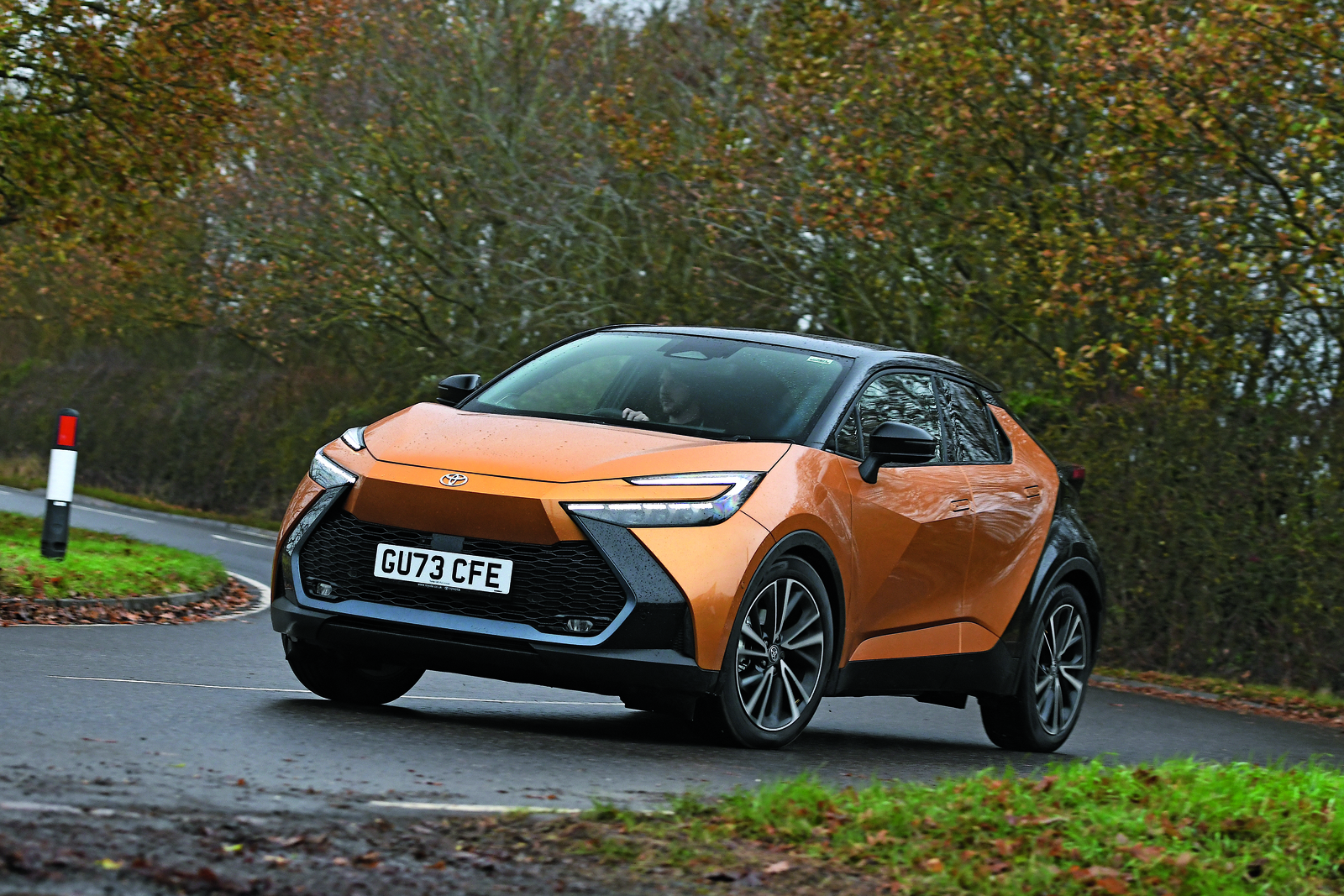
- Design8
- Interior7
- Performance7
- Ride & Handling8
- Costs8
Pros
Head-turning style
Nicely judged ride and handling balance
Good EV range
Cons
Cramped back seats
Plug-in hybrid gets smaller boot
PHEV also gains little in terms of performance
Best for: Real-world economy
Toyota went bold with its second-generation CH-R, which builds on the success of the original with an even more eye-catching design. With its coupé-inspired looks and neat two-tone paint scheme, the high-riding crossover easily stands out from the company car crowd.
Whichever hybrid option you choose, you’re unlikely to be disappointed by the Toyota C-HR’s economy
The interior has been given an equally thorough going-over, with a neater design and an extra injection of premium appeal. It also benefits from Toyota’s latest and easier-to-use infotainment, plus an array of advanced driver aids, which will be music to the ears of any fleet manager grappling with the company car risk assessment spreadsheet.
Less impressive is the amount of room for rear passengers, who will be made to feel even more cramped by the tiny side windows. Accommodating the hybrid running gear also shrinks the boot to a supermini-sized 310 litres
On the plus side, there’s plenty of substance to go with the style. Thanks to the brand’s TNGA architecture, the CH-R is good to drive, with naturally balanced handling and a supple ride. It’s also boosted by a new, smoother and more refined plug-in hybrid drivetrain that develops 220bhp and offers a claimed 41 miles of EV running for a 9% BIK rating.
Read our Toyota C-HR review
Save money on a new Toyota C-HR with What Car?
Finance this car with Drivenfi
Back to top
6. Renault 5
9
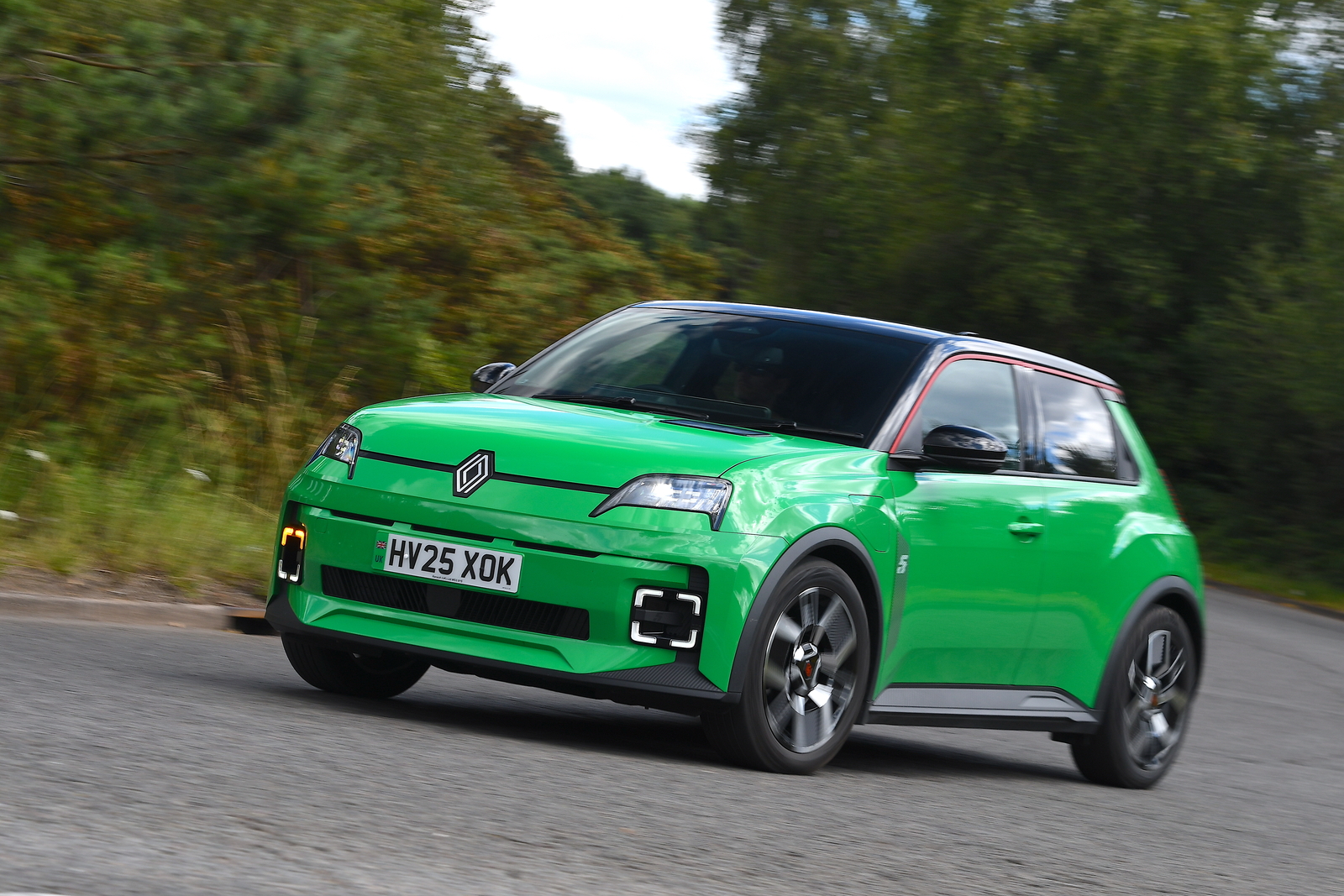
- Design10
- Interior9
- Performance8
- Ride & Handling9
- Costs8
Pros
Excellent ride-handling balance
Fine value for money
Fantastic interior design
Cons
Disappointing cruising range
Doors feel and sound tinny
Rivals are quicker
Best for: Style
We’ve already named the Renault 5 as the best small electric car, but we also think France’s fantastic retro EV is a great option for company car drivers specifically.
At 1461kg on the road test weighbridge, the Comfort Range 5 is a good deal lighter than the Mini equivalent, to the benefit of its ride and handling.
A genuine class-leader in its field, the Renault 5 possesses great handling, a brilliant ride quality and an interior with high-end materials.
The Renault 5 gets a 148bhp electric motor that’s powerful enough for daily driving and commuting. You can cover 0-62mph in 7.9sec and the claimed range stands at 250 miles from a 52kWh battery.
Of course, because the Renault 5 is electric, it produces zero emissions so lands in the 3% BIK band, which means you’ll pay a basic rate of £162 a year in tax if you opt for the Comfort specification level.
Read our Renault 5 review
Save money on a new Renault 5 with What Car?
Finance this car with Drivenfi
7. Cupra Born
9
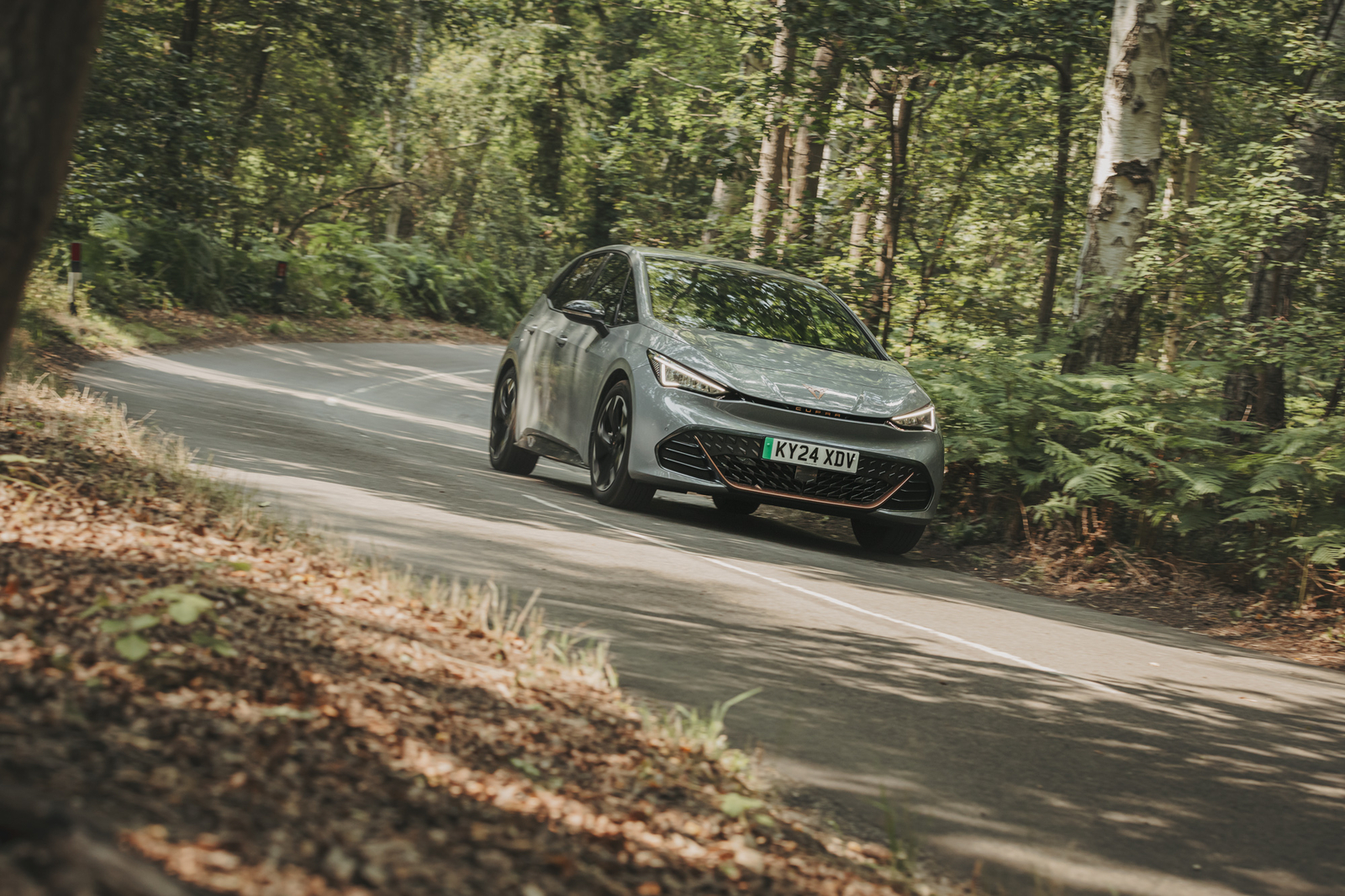
- Design8
- Interior9
- Performance8
- Ride & Handling9
- Costs8
Pros
Impressive efficiency
Rear-drive chassis is poised and rewarding
Roomy and comfortable interior
Cons
Infotainment still has some usability niggles
Rivals offer more outright design appeal
You can get more power and range for the money elsewhere
Best for: Handling
The Cupra Born has been on sale for several years now, but it’s still an excellent electric option and merits serious consideration as a small company car.
The Cupra Born is at the top of the compact EV class for driver appeal, even in entry-level form.
Few models offer a finer blend of practicality, power, real-world range and fun, and it’s just as impressive in the money stakes. It’s a zero-emissions car, which means a 3% BIK banding and low annual tax bill.
The overall package is substantial. The Born gets rear-wheel drive as standard and either 201bhp or 227bhp. It’s seriously rewarding to drive, with great agility levels and well-balanced handling. Essentially, the Born feels like a GTI for the electric era.
Depending on the battery size you choose (either a 59kWh or a 79kWh unit), Cupra’s Volkswagen ID 3 rival offers between 259 and 364 miles of range. That’s a competitive figure in today’s market.
The range-topping Cupra Born VZ is a more hardcore option with 322bhp and 402lb ft of torque. It hits 0-62mph in 5.7sec – over one second faster than the regular Born.
Read our Cupra Born review
Save money on a new Cupra Born with What Car?
Finance this car with Drivenfi
Back to top
8. Skoda Elroq
9
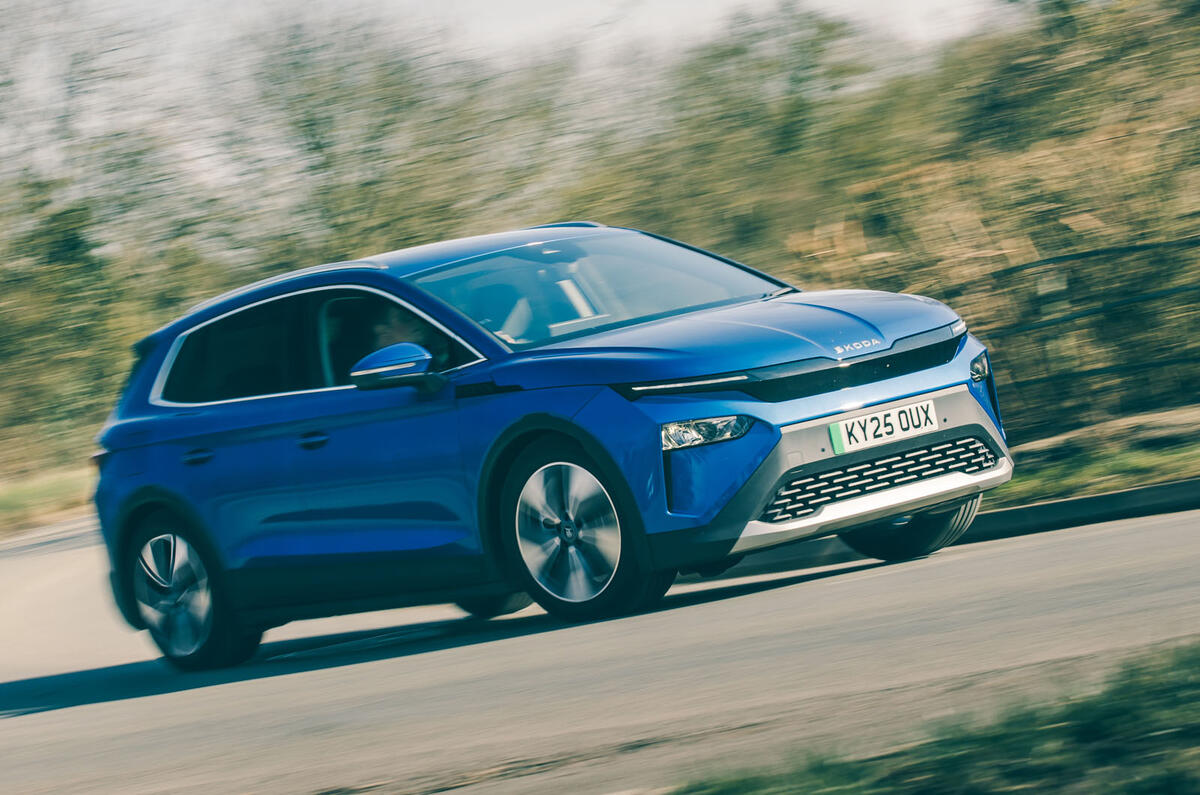
- Design8
- Interior9
- Performance9
- Ride & Handling8
- Costs9
Pros
Well-rounded drive, thanks to mature chassis
Spacious interior features plenty of usable tech
Strong real-world efficiency
Cons
Not a car for those seeking driver fun
It’s relatively heavy and feels it on out-of-town roads
DCC suspension is limited to pricier models
Best for: Families
The Skoda Elroq takes the same combination of ability on show in the larger Enyaq and squeezes them into a more compact package.
The Elroq isn’t the boxiest or loftiest compact SUV, but it’s nonetheless easy to get into, and there’s enough head room and seat-base height adjustability to perch up high and boost visibility.
Majoring on comfort, practicality and an eye-catching design, the Elroq also benefits from an enticing entry price of just over £30,000.
So in addition to being zero-emission and sitting in the 3% BIK bracket, it attracts far less in tax per year than many other company cars.
In the range department, the Elroq comes with a wide choice of battery sizes, starting with a 52kWh unit with 232 miles, rising to 77kWh and 360 miles of range. Power ranges from 168bhp to 282bhp.
Read our Skoda Elroq review
Save money on a new Skoda Elroq with What Car?
Finance this car with Drivenfi
9. Tesla Model 3
8
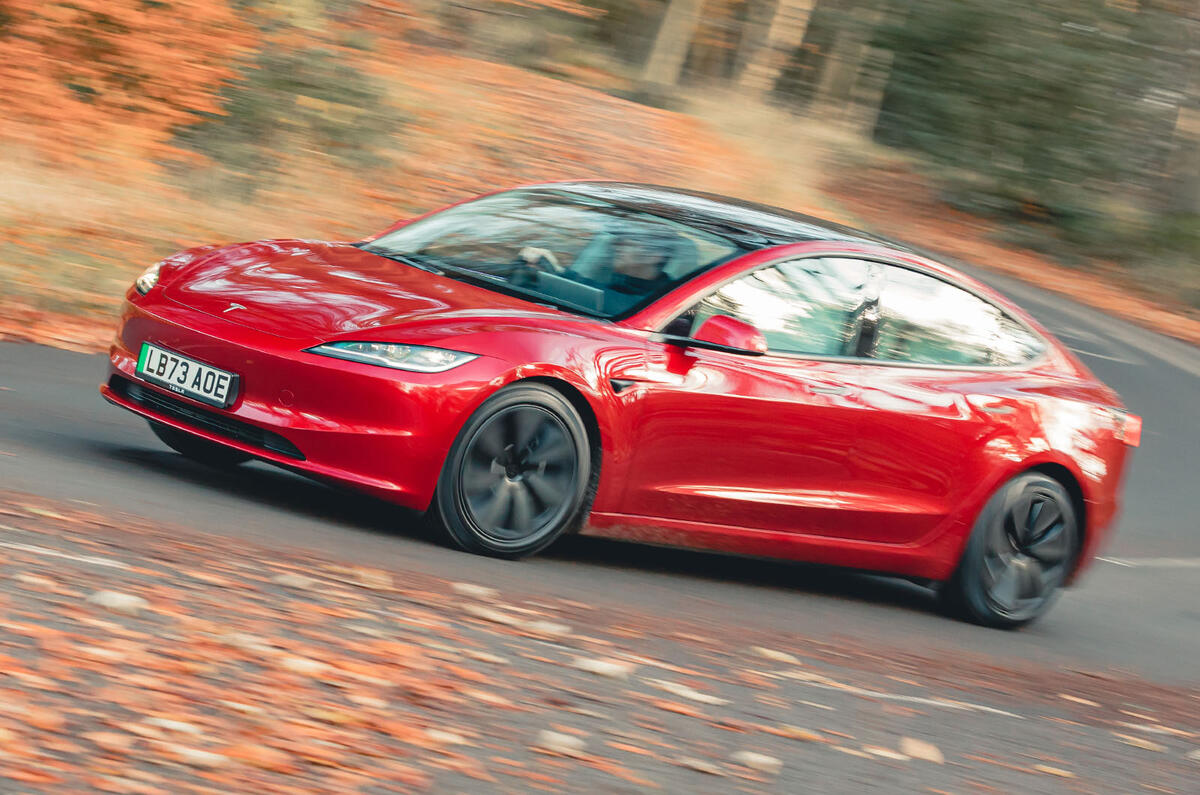
- Design8
- Interior8
- Performance10
- Ride & Handling7
- Costs8
Pros
Punchy performance is matched by a deep-seated sense of agility
Quality of the lounge-like interior really does feel better than ever
Range and drivability make the Model 3 fabulously easy to live with
Cons
Still wants for rolling refinement, especially on choppy British roads
Autopilot functions need greater finesse and can’t be entirely trusted
Minimalistic interior can be a headache when it comes to functionality
Best for: Power
The Tesla Model 3 is the largest car on this list, but its merits as a company car cannot be ignored.
Few cars offer up performance as easily as the Model 3 Long Range, and the car’s almost toy-like demeanour belies the magnitude of that performance.
Updated in 2024, the Model 3 gained a sharper front end and a higher-quality interior. It remains as practical as ever, with a combined storage space of 682 litres in the boot and front trunk combined.
The blend of performance and range helps the Model 3 stand out against its rivals. Even basic rear-wheel-drive cars get 241bhp, while range-topping all-wheel-drive variants have 491bhp.
As for range, the Model 3 offers a choice of standard- and extended-range variants, with between 344 miles and 391 miles available depending on specification.
Like the Cupra Born, MG 4 and Renault 5, the Model 3 has a 3% BIK banding, which means you’ll pay from £240 a year on a basic rate salary.
Read our Tesla Model 3 review
Save money on a new Tesla Model 3 with What Car?
Finance this car with Drivenfi
Back to top
10. Kia EV3
8
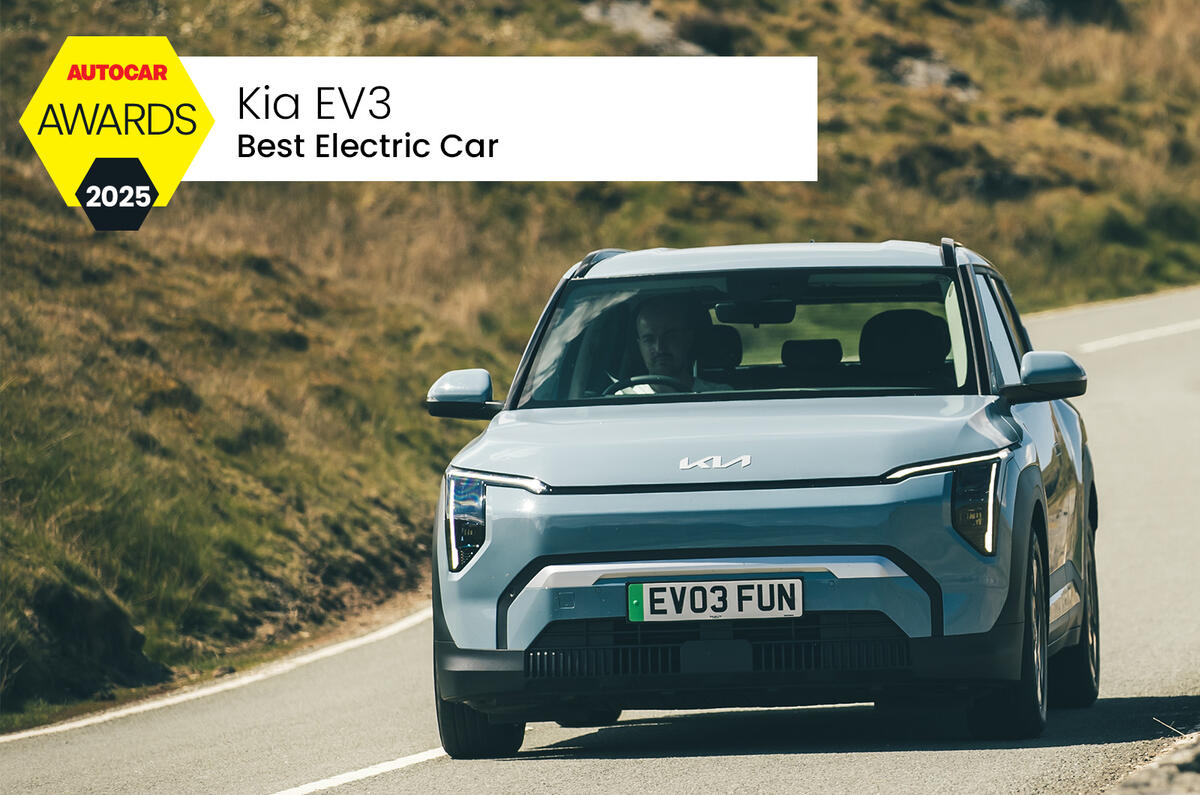
- Design9
- Interior9
- Performance8
- Ride & Handling6
- Costs8
Pros
Large battery for the class
Excellent infotainment and usability
Outstanding drivability and regen control
Cons
Awful ADAS
Bland to drive
Expensive on PCP
Best for: Versatility
The Kia EV3 is our Best Electric Car of 2025, and it’s a top pick if you’re after a smaller company car. It sits in the 3% BIK banding, and grabbing one through a company car scheme is a smart move.
It grips well and its body doesn’t roll excessively, but there is an indirectness to the EV3’s front axle that makes it feel a tad lethargic when you tip into a corner with some enthusiasm.
The EV3 is positioned to rival the Cupra Born and Volkswagen ID 3, almost as a hatchback but with crossover levels of practicality. All EV3s get a 460-litre boot, which increases to 1250 litres with the seats folded down.
Battery sizes range from 267 miles with the entry-level 58.3kWh battery up to 375 miles with the 81.4kWh battery.
Overall, the EV3 is easy to drive and live with, with faster charging speeds than most other rivals in the class too. Just be warned that Hyundai’s ADAS features aren’t the most cooperative and can frustrate at times.




